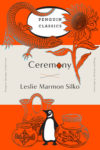by Leslie Marmon Silko, 1977
 This was our first book for the Old Town Library Book Club for 2018-2019. We met and discussed it on 10-15-18. Most everyone liked the book although some did not like the ending. I think it was rather violent but I can’t really recall the ending. I loved the main character, Tayo, who was a half-breed Indian abandoned by his mother and raised by his Christian Aunt on the Navajo Indian reservation. He was always a shame to his Aunt, because of his mother, her sister. He and his cousin, Rocky, enlisted in the Army during WWII and were sent to the Pacific. They ended up on the Bataan death march and Tayo was unable to save Rocky who died a horrible death at the hands of the Japanese on that march.
This was our first book for the Old Town Library Book Club for 2018-2019. We met and discussed it on 10-15-18. Most everyone liked the book although some did not like the ending. I think it was rather violent but I can’t really recall the ending. I loved the main character, Tayo, who was a half-breed Indian abandoned by his mother and raised by his Christian Aunt on the Navajo Indian reservation. He was always a shame to his Aunt, because of his mother, her sister. He and his cousin, Rocky, enlisted in the Army during WWII and were sent to the Pacific. They ended up on the Bataan death march and Tayo was unable to save Rocky who died a horrible death at the hands of the Japanese on that march.
Tayo returns to the reservation and is tormented by the memories. He drinks along with others on the reservation. Every time something triggers the memories, he becomes violently ill. Finally, they send him to a medicine man who somehow cures him, although it is a slow process. Tayo goes on a journey to find his uncle’s cattle and bring them back from the white man’s ranch. Beautiful sense of place, and Tayo is a beautiful, deep man. The book is non-linear and it was difficult to figure out where you were sometimes, but I take with me the feeling of Tayo being in the mountains, on his horse, searching for the cattle, finding them, cutting a hole in the fence, getting caught by two cowboys but they let him go when a mountain lion is spotted. He survives a night in a raging storm, then rescues those cows and takes them to a canyon where they live for the summer. There is a time he is with a woman who may or may not have been real, but they love one another and she is a healer, and their love heals him. Then she disappears. I also loved the foreword by the author in which she describes moving to Alaska (Ketchikan, I think) where it is rainy and wet and she started having migraines, but began writing this book and it cured her of her migraines. Beautiful book. Here are a few sentences in which she is describing the destroyers, page 178:
…thievery and injustice boiling up the anger and hatred that would finally destroy the world: the starving against the fat, the colored against the white. The destroyers had only to set it into motion, and sit back to count the casualties. But it was more than a body count; the lies devoured white hearts, and for more than two hundred years white people had worked to fill their emptiness; they tried to glut the hollowness with patriotic wars and with great technology and the wealth it brought. And always they had been fooling themselves, and they knew it.
Good book.